21.5-inch iMac (Late 2013) Review: Iris Pro Driving an Accurate Display
by Anand Lal Shimpi on October 7, 2013 3:28 AM ESTThe Display
When it was first announced, I shrugged off the 21.5-inch iMac model. At the time I was using a 27-inch Thunderbolt Display and couldn’t see myself using anything smaller, or lower resolution. With the new 27-inch iMac looking a lot like last year’s model with evolutionary upgrades on the internals, I was obviously drawn to the new 21.5-inch system because of its use of Intel’s Iris Pro 5200 graphics so I ended up with the first < 3MP desktop display I’d used since the release of the first 30-inch 2560 x 1600 panels years ago.
Given how much time I spend on notebook displays these days, now was as good a time as any to go back to a 1080p desktop display. While I’d prefer something with an insanely higher resolution, it’s still too early for a 21.5-inch 4K panel (or a 27-inch 5K panel), which Apple would likely move to in order to bring Retina displays to its desktops.
There are two reasons why you’d opt for the 21.5-inch iMac vs. the larger one: cost and size. At a bare minimum you’re looking at a $500 price difference between the 21.5 and 27-inch iMacs, which is pretty substantial to begin with. The size argument is just as easy to understand. The 27-inch iMac occupies a considerable amount of space on my desk, and I’ve come to realize that not everyone likes to be surrounded by a sea of desks. Either way there’s clearly a market for a computer this size, with this sort of a resolution. So how does the display fare?
In short: it’s nearly perfect.
Brian and I were comparing notes on the two reviews we’re working on at the same time. He sent me some CIE diagrams showing me color accuracy for the displays he’s testing, I responded with this:

21.5-inch iMac (Late 2013) Saturations
Those boxes show what’s expected, the circles inside of them show what’s delivered by the display. The 21.5-inch iMac is spot on, out of the box, without any calibration required. Brian’s response:
WOW
is that out of the box?
The iMac’s display does extremely well in all of our tests, always turning in a delta E of less than 2. It’s just incredible. I'm borrowing the graphs below from our tablet bench data, but I've tossed in the 2013 MacBook Air as a reference point.

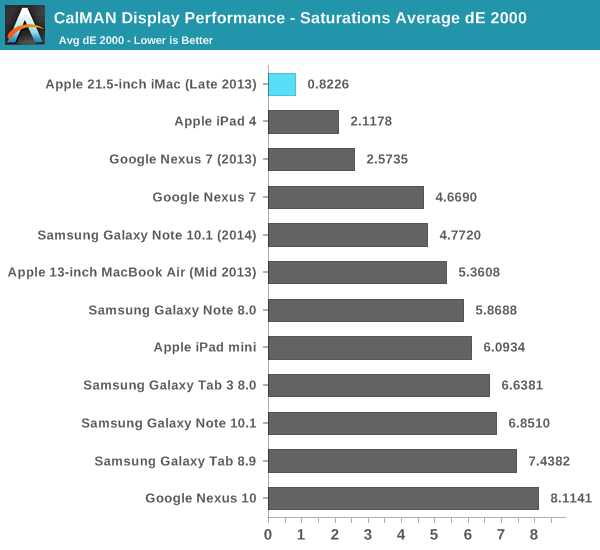
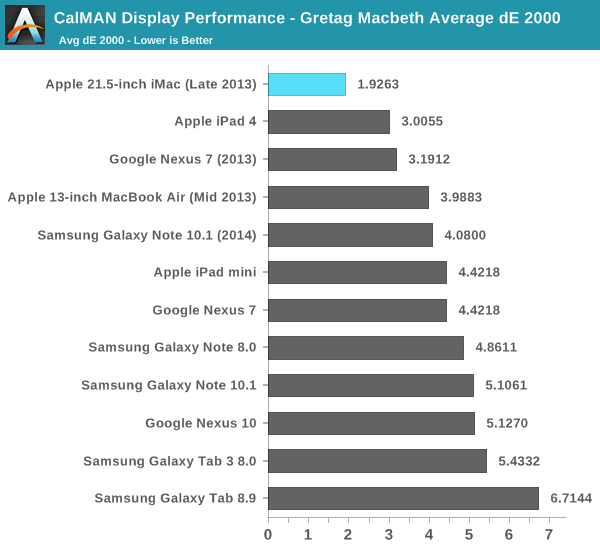

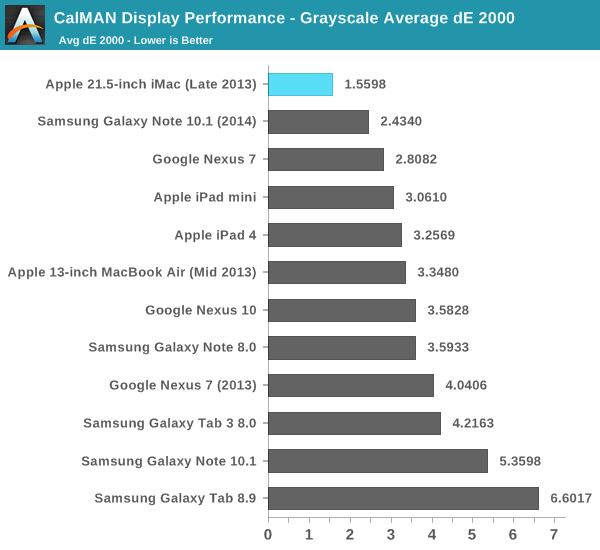
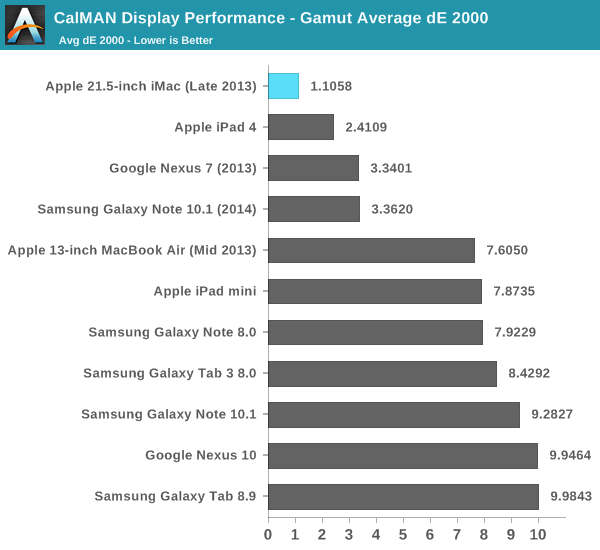

Although I doubt Apple’s intended audience for the entry-level 21.5-inch iMac are imaging professionals, they could very well use the system and be perfectly happy with it. Literally all that’s missing is a 2x resolution model, but my guess is it’ll be another year before we see that.
I have to point out that Apple does source its display panels from multiple providers (typically 2 or 3), not to mention panel variance within a lot. I don’t anticipate finding many panels better than the one in my review sample, but it’s always possible that there will be worse examples in the market. I haven’t seen huge variance in color accuracy from Apple panels, so I think it’s a pretty safe bet that what you’re going to get with any new iMac is going to be awesome.



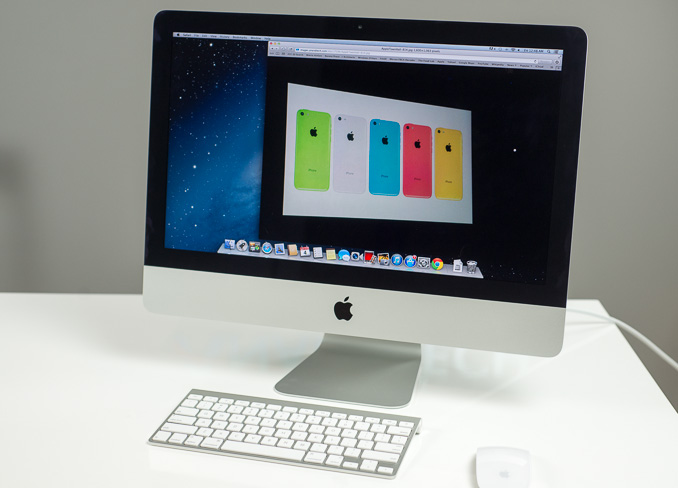











127 Comments
View All Comments
Anand Lal Shimpi - Monday, October 7, 2013 - link
Good call - unfortunately no, Crystalwell isn't reported there either.Dman23 - Monday, October 7, 2013 - link
Great review! Thanks for taking the time to review the New iMacs. The Iris Pro 5200 looks extremely interesting.Guspaz - Monday, October 7, 2013 - link
It's amusing to me that the 27" iMac is smaller and thinner than my Dell 27" monitor (the U2711), even though the iMac is a full comptuer while my U2711 is just a monitor.1andrew - Monday, October 7, 2013 - link
The iMac's have a great display and Target Display Mode is a cool feature. I would really like to see them expand it to non-Thunderbolt/Apple devices. I would love to play my 360 without needing a second display.twistedgamez - Monday, October 7, 2013 - link
why don't reviewers test dota2? i know it's not a particularity intensive game, but lots of people play it (often 10 x number of players of the second game on steam) and lots of people would like to know how it performs, especially when you up the resolution, and lots of people only play dota2 so its not particularly easy to judge its performance when seeing metro/tr performance on lower resolutionsbut other than that, a great review!
bluevaping - Monday, October 7, 2013 - link
I know you guys wanted to get a review out, but I think you will see a jump in performance with the upcoming Os X to be released next month. I bet there will be better optimized drivers and support for Open Cl 1.2 and Open GL 4.0jasonelmore - Monday, October 7, 2013 - link
+$250 for nothing but a 128gb ssd for fusion drive is rape.repoman27 - Monday, October 7, 2013 - link
Well, in the US, it's only a $200 adder. And it's a rather performant PCIe based SSD. Have you priced out an alternative that's as fast or faster for less money? Don't get me wrong, Apple maintains a 36% gross margin which is probably considerably higher than, say, Newegg's, but what were you really expecting for this type of CTO option?nerd1 - Tuesday, October 8, 2013 - link
You can get 256 sata3 ssd at much less than 200. They are also charging 200 for extra 8gb of ram.repoman27 - Wednesday, October 9, 2013 - link
Yes, you can get a considerably slower SSD with a crappy controller and lower endurance NAND for less money than Apple's offerings.The RAM is another matter entirely. It's unfortunate they made it such a hassle to upgrade the RAM yourself in the 21.5" model.